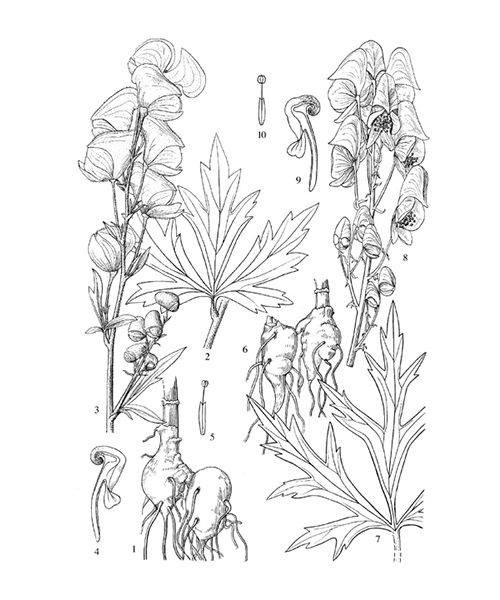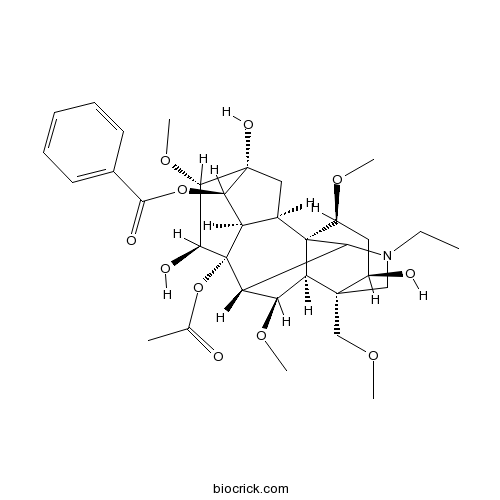Aconitum kusnezoffii
Aconitum kusnezoffii
1. The products in our compound library are selected from thousands of unique natural products; 2. It has the characteristics of diverse structure, diverse sources and wide coverage of activities; 3. Provide information on the activity of products from major journals, patents and research reports around the world, providing theoretical direction and research basis for further research and screening; 4. Free combination according to the type, source, target and disease of natural product; 5. The compound powder is placed in a covered tube and then discharged into a 10 x 10 cryostat; 6. Transport in ice pack or dry ice pack. Please store it at -20 °C as soon as possible after receiving the product, and use it as soon as possible after opening.

Natural products/compounds from Aconitum kusnezoffii
- Cat.No. Product Name CAS Number COA
-
BCN5987
Mesaconitine2752-64-9
Instructions

-
BCN1014
Aconitine302-27-2
Instructions

-
BCN2797
3-Deoxyaconitine3175-95-9
Instructions

-
BCN5988
Hypaconitine6900-87-4
Instructions

[Content determination of four diester diterpenoid alkaloids in leaves of Aconitum kusnezoffii by HPLC].[Pubmed: 29600653]
This present study is to develop an HPLC method for simultaneous determination of four diester diterpenoid alkaloids, beiwutine, mesaconitine, hypaconitine and aconitine in the leaves of Aconitum kusnezoffii, so as to provide evidence of the quality control of this herb. The four constituents were measured on a Waters XBridge CC₁₈ column(4.6 mmχ250 mm, 5 μm). The mobile phase was acetonitrile-40 mmol·L⁻¹ ammonium acetate solution(adjusted pH to 10.5 with ammonia solution)(33:67) with isocratic elution at a flow rate of 1.0 mL·min⁻¹; the detection wavelength was 235 nm; the column temperature was 30 °C, and the injection volume was 10 μL. Next, this contents of the four diester diterpenoid alkaloids in 12 samples were 0.025 5-0.088 5, 0.039 1-0.071 5, 0.026 6-0.081 0 and 0.008 12-0.031 2 mg·g⁻¹, respectively. Next, this method has been successfully applied to the analysis of A. kusnezoffii folium in different harvest periods. The contents of the four alkaloids decreased primarily, and then increased with the postponing of harvest. The established method is proved to be accurate and sensitive for the determination of alkaloids in A. kusnezoffii folium, and may be useful for the quality improvement of this herbal medicine. Moreover, these results indicated the scientific significance for the toxicity and the suitable harvest time of this herb.
An integrative investigation of the toxicity of Aconiti kusnezoffii radix and the attenuation effect of its processed drug using a UHPLC-Q-TOF based rat serum and urine metabolomics strategy.[Pubmed: 28668652]
Aconiti kusnezoffii radix (AKR), the root of Aconitum kusnezoffii Reichb., is commonly used in the treatment of the rheumatoid arthritis. However, the clinical application is limited due to its potential toxicity. Therefore, to investigate the mechanism of its potential neurotoxicity and nephrotoxicity, a comprehensive metabolomics study combined with serum biochemistry and histopathology measurements was carried out. A UHPLC-Q-TOF mass spectrometry based metabolomics approach was applied to characterize the AKR toxicity, while the toxicity attenuation effects of Aconiti kusnezoffii radix cocta (AKRC) on Wistar rats were also investigated. Two chromatographic techniques involving reversed-phase chromatography and hydrophilic interaction chromatography were combined for the serum and urine detection, which balanced the integrity and selectivity of the two matrices. Principal component analysis was used to determine the groups, and principal component analysis discriminant analysis was carried out to confirm the important variables. Then, the developed integrative toxicity evaluation method was applied to assess the toxicity of AKR and the attenuation effect of AKRC. The highly sensitive and specific toxic biomarkers, which can provide practical bases were identified for the diagnosis of the neurotoxicity and nephrotoxicity induced by AKR. In all, a total of 19 putative biomarkers were characterized, and related metabolic pathways were identified. The study demonstrated that the established metabolomics strategy is a powerful approach for investigating the mechanisms of herbal toxicity and the attenuation effect of a processing method and would provide medical solutions for other toxic herbal medications and further clinical evidence on how AKR improves symptoms of rheumatoid arthritis patients.
A feasible, economical, and accurate analytical method for simultaneous determination of six alkaloid markers in Aconiti Lateralis Radix Praeparata from different manufacturing sources and processing ways.[Pubmed: 28527516]
Aconiti Lateralis Radix Praeparata (Fuzi) is a commonly used traditional Chinese medicine in clinic for its potency in restoring yang and rescuing from collapse. Aconiti alkaloids, mainly including monoester-diterpenoidaconitines (MDAs) and diester-diterpenoidaconitines (DDAs), are considered to act as both bioactive and toxic constituents. In the present study, a feasible, economical, and accurate HPLC method for simultaneous determination of six alkaloid markers using the Single Standard for Determination of Multi-Components (SSDMC) method was developed and fully validated. Benzoylmesaconine was used as the unique reference standard. This method was proven as accurate (recovery varying between 97.5%-101.8%, RSD < 3%), precise (RSD 0.63%-2.05%), and linear (R > 0.999 9) over the concentration ranges, and subsequently applied to quantitative evaluation of 62 batches of samples, among which 45 batches were from good manufacturing practice (GMP) facilities and 17 batches from the drug market. The contents were then analyzed by principal component analysis (PCA) and homogeneity test. The present study provided valuable information for improving the quality standard of Aconiti Lateralis Radix Praeparata. The developed method also has the potential in analysis of other Aconitum species, such as Aconitum carmichaelii (prepared parent root) and Aconitum kusnezoffii (prepared root).
Characterization of 19 microsatellite loci in the clonal monkshood Aconitum kusnezoffii (Ranunculaceae).[Pubmed: 27347450]
Microsatellite loci were isolated and characterized from Aconitum kusnezoffii (Ranunculaceae) to estimate male and female reproductive success and evaluate the effects of clonal growth on sexual reproduction.


